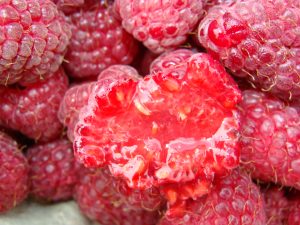Spotted Wing Drosophila Alert: August 9, 2019

SPOTTED WING DROSOPHILA ALERT: AUGUST 9, 2019
David Handley, Vegetable and Small Fruit Specialist; James Dill, Pest Management Specialist; Frank Drummond, Professor of Insect Ecology/Entomology; Christina Howard, Produce Safety Professional
Spotted wing drosophila (SWD) fruit fly numbers increased at nearly all of the berry farm locations we are monitoring in Maine this week. We are seeing similar reports throughout the northeast, indicating that SWD pressure continues to build, and growers with susceptible crops, including raspberries, blackberries, blueberries and strawberries now need to apply protective sprays or covers to keep fruit from becoming infested with larvae.
Fly counts this week at nearly all sites were above the suggested spray threshold of 6 to 10 flies caught in a yeast-baited trap. Research suggests that when trap counts exceed this level larvae will start appearing in the fruit.

We expect spotted wing drosophila populations to continue to build in the coming weeks as more food (fruit) becomes available for the flies. The buildup could be very rapid, especially if conditions remain warm and wet. Start protective sprays on any berries that have begun to ripen, and continue to spray on a 7-day schedule, until numbers drop below threshold. If a 7-day spray schedule becomes inadequate for halting larvae infesting the fruit, a 5-day spray schedule would be recommended.
In the field, the best way to keep SWD populations from exploding are to clean up any waste fruit in the planting; do not allow rotten or over ripe fruit to stay on the ground. Further, promote dry conditions in the field by pruning out excessive low vegetative growth on raspberry and blueberry plants to allow more light and air movement within and between the plant rows.
Salt Water Test for Spotted Wing Drosophila Larvae
You can perform a simple test to determine if your fruit are infested with SWD larvae by immersing some berries in a salt water solution to force any larvae out of the fruit where they can more easily be observed. A good fact sheet on the test is available from the Ohio State University, Salt Water Test for Spotted Wing Drosophila (SWD) Larvae (PDF).
For more information on identifying spotted wing drosophila (SWD) and updates on populations around the state, visit our SWD blog.
Other IPM Web Pages
Michigan State University
Penn State University
University of New Hampshire
David T. Handley
Vegetable and Small Fruit Specialist
Highmoor Farm UMaine Extension Diagnostic Research Lab
P.O. Box 179 Pest Management Unit
52 U.S. Route 202 17 Godfrey Drive
Monmouth, ME 04259 Orono, ME 04473
207.933.2100 1.800.287.0279
Where brand names or company names are used it is for the reader’s information. No endorsement is implied nor is any discrimination intended against other products with similar ingredients. Always consult product labels for rates, application instructions and safety precautions. Users of these products assume all associated risks.
The University of Maine is an equal opportunity/affirmative action institution.
| Town | Spotted Wing Drosophila weekly trap catch 7/26/19 | Spotted Wing Drosophila weekly trap catch 8/2/19 | Spotted Wing Drosophila weekly trap catch 8/9/19 |
|---|---|---|---|
| Sanford | 8 | 2 | 47 |
| Limington | 46 | 144 | 364 |
| Limerick | 0 | 0 | 9 |
| Cape Elizabeth | 85 | 73 | 211 |
| Buxton | 2 | 14 | 37 |
| Bowdoinham | 55 | 62 | 82 |
| Poland Spring | 1 | 0 | 29 |
| Mechanic Falls | 0 | 1 | 4 |
| Monmouth* | 16 | 39 | 126 |
| Farmington | 1 | 10 | 42 |
| Wayne | 1 | 17 | 7 |
| Wells | 56 | 4 | 15 |
*unsprayed planting
